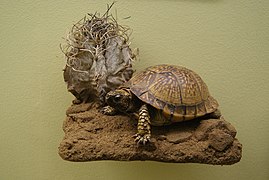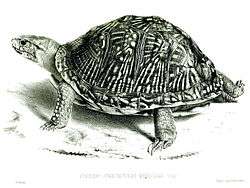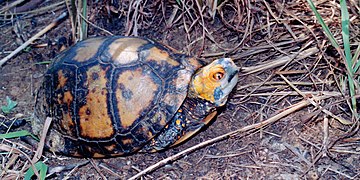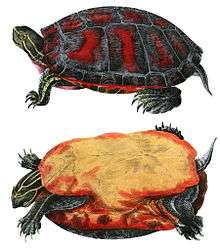Mexican box turtle
The Mexican box turtle (Terrapene mexicana) is a species of box turtle belonging to the family Emydidae. It is sometimes treated as a subspecies of Terrapene carolina (Terrapene carolina mexicana).[2]
| Mexican box turtle | |
|---|---|
_(1).jpg) | |
| Terrapene mexicana at Zoo Atlanta | |
| Scientific classification | |
| Kingdom: | Animalia |
| Phylum: | Chordata |
| Class: | Reptilia |
| Order: | Testudines |
| Suborder: | Cryptodira |
| Superfamily: | Testudinoidea |
| Family: | Emydidae |
| Genus: | Terrapene |
| Species: | T. mexicana |
| Binomial name | |
| Terrapene mexicana | |
| Synonyms[2][3] | |
|
List
| |
Geographic range
This species is endemic to Mexico. It is found in the Mexican states of Tamaulipas, Veracruz and San Luis Potosí.[1][4]
Habitat
It lives in areas with tropical climates within humid forests at shallow rainwater puddles.[5]
Description
Terrapene mexicana can reach a length of about 18–20 cm (7.1–7.9 in).[5] The carapace is long and dome-shaped, with rather variable color and markings. The adult males show gray-blue nuances on the head and red or orange nuances on the front legs.[5]
Biology
The Mexican box turtle does not have much information on them because very few of them are domesticated (kept as pets). However, we do know that they have a lifespan of 100 years. Usually these turtles have water nearby homes and a bush to hide. Having a home by the water will attract insects, which are a big part of their diet.
Gallery
_(2).jpg) Terrapene mexicana at the Zoo Atlanta
Terrapene mexicana at the Zoo Atlanta A Mexican box turtle on display in Gothenburg Natural History Museum
A Mexican box turtle on display in Gothenburg Natural History Museum Illustration from Proceedings of the Zoological Society of London 1848-1849
Illustration from Proceedings of the Zoological Society of London 1848-1849 Mexican box turtle (Terrapene mexicana) in the field in southern Tamaulipas, Mexico
Mexican box turtle (Terrapene mexicana) in the field in southern Tamaulipas, Mexico
- Bibliography
- Rhodin, Anders G.J.; van Dijk, Peter Paul; Inverson, John B.; Shaffer, H. Bradley; Roger, Bour (2011-12-31). "Turtles of the world, 2011 update: Annotated checklist of taxonomy, synonymy, distribution and conservation status". Chelonian Research Monographs. 5.
- Fritz, Uwe; Havaš, Peter (2007). "Checklist of Chelonians of the World". Vertebrate Zoology. 57
- Dodd, C. Kenneth. North American Box Turtles a Natural History. University of Oklahoma Press, 2002.
- Milstead, William W., and Donald W. Tinkle. "Terrapene of Western Mexico, with Comments on the Species Groups in the Genus". Copeia, vol. 1967, no. 1, 1967, p. 180., doi:10.2307/1442193
- Stone, Lynn M. Nature Watch: Box Turtles. Lynn M. Stone, 2007.
External links
References
| Wikispecies has information related to Mexican box turtle |
| Wikimedia Commons has media related to Mexican box turtle. |
- Rhodin, Anders G.J.; van Dijk, Peter Paul; Inverson, John B.; Shaffer, H. Bradley; Roger, Bour (2011-12-31). Turtles of the world, 2011 update: Annotated checklist of taxonomy, synonymy, distribution and conservation status Chelonian Research Monographs. N. 5
- Fritz, Uwe; Havaš, Peter (2007). "Checklist of Chelonians of the World"
- The Reptile Database
- iNaturalist
- Herpetomania(in Italian)
